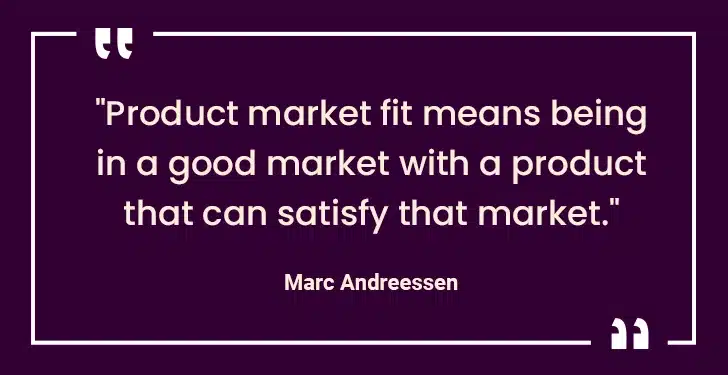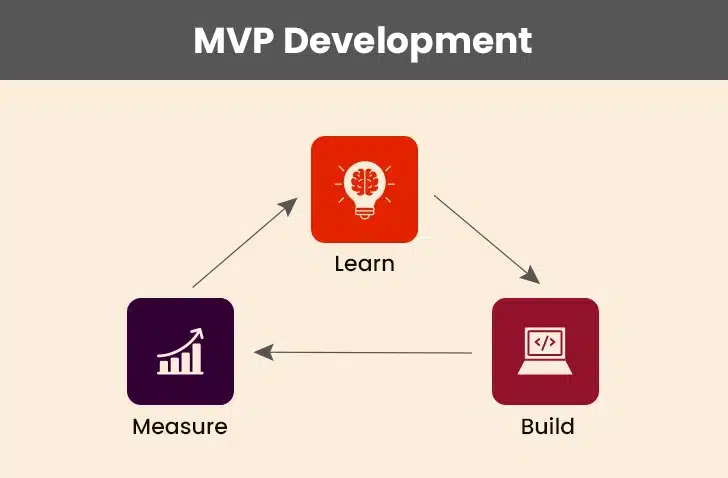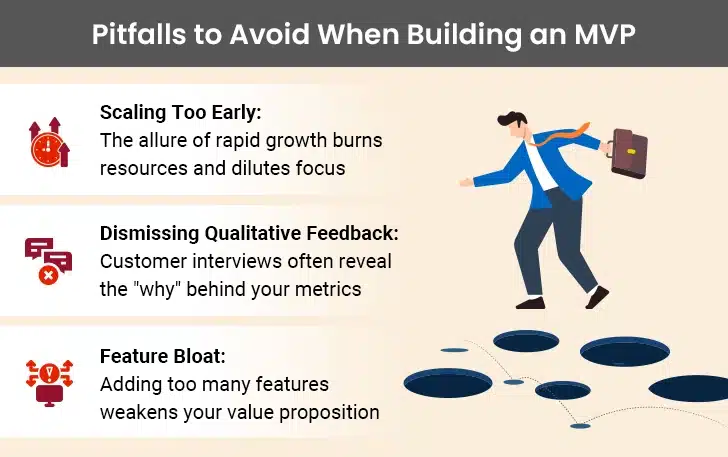Startups using MVP strategies often outperform competitors racing to scale. Why? Because launching small avoids burning resources on unproven ideas. This makes strategic, lean development essential.
Successful MVPs solve real-world problems with minimal features. This preserves resources while testing core assumptions. But success hinges on reaching product-market fit: proving your solution resonates with your customers. Many fail by not truly understanding their audience’s needs. Imagine building a house—you’d never add walls before testing if the foundation works. Likewise, it’s vital to validate your idea’s core before expanding. Start small, learn fast, then grow intentionally.
This blog talks about strategies to develop MVPs efficiently and transform them into products that achieve market fit. It explores how teams can validate ideas quickly and enter new markets while avoiding pitfalls that derail many promising ventures.
Table of Contents
Why Start with a Minimum Viable Product (MVP)
MVP App Development: A Step-by-Step Approach
Essential Strategies to Bridge MVP and PMF
Tools and Frameworks to Accelerate PMF
- I. The Lean Startup Methodology (Build, Measure, Learn)
- II. Analytics Tools for Deeper Insights
- III. Roadmap Prioritization Frameworks
Why Start with a Minimum Viable Product (MVP)
“Product market fit means being in a good market with a product that can satisfy that market.” — Marc Andreessen, co-founder of venture capital firm Andreessen Horowitz.
The concept of a minimum viable product has changed modern business strategy. Instead of building a feature-heavy product that might miss the mark, companies create a basic version with just enough features to validate their ideas. This way, they are able to test their product without draining resources.
1. Cost-Effectiveness
Building an MVP needs substantially fewer resources than a complete product. This makes it budget-friendly for startups and small businesses. Teams can manage their expenses better by focusing just on core features in the initial phases. Non-essential features can be added later. Smart resource allocation lets teams test market viability before making bets on large-scale projects.
2. Faster Time-to-Market
Being first to market can deliver a substantial competitive advantage. Companies that build a minimum viable product can launch their solution faster than those waiting to perfect every feature. Quick entry to the market helps businesses:
- Test ideas with actual users
- Collect user data right away
- Secure a first-mover advantage
- Build brand awareness while improving the product
3. Validation Through Feedback
Minimum viable products shine when it comes to gathering valuable feedback from users. Businesses receive evidence-backed data on which features work and what users actually need. It helps them assess if their product resonates with target audiences. No need to use guesswork or rely solely on market research.
4. Risk Mitigation
MVPs allow businesses to test their ideas in the market before investing in a full-scale product. If users don’t respond well, they can pivot or iterate based on feedback. No need to waste resources on an unwanted product.
5. Attracting Investment
These days, investors want proof of market validation before committing their funds. A working MVP attracts potential investors by showing your ability to execute and adapt. Proven proof of concept creates a strong business case. This improves your chances of receiving funding.
The Promise and Perils of MVPs in Tech Startups
6. Building an Early Adopter Base
Creating an MVP helps you attract early adopters—users ready to try new products. Businesses that deliver quality products turn these users into brand promoters. They provide genuine feedback, spread the word, and help your user base grow.
MVP App Development: A Step-by-Step Approach
MVP app development needs a delicate balance between speed and smart decision-making. A well-structured roadmap helps businesses move from a concept to a viable product with confidence.
I. Conduct Market Research to Identify Gaps
Every successful MVP starts with thorough market research. Businesses need to examine their competitors to understand the solutions that exist today. This analysis reveals untapped opportunities your product could address. Talking to a few potential customers could uncover several pain points, creating many more opportunities.
Effective market research should include an analysis of:
- Industry trends and forecasts
- Customer feedback on competitor products
- Technological gaps that might give you an edge
- Regulatory requirements in your target market
II. Develop a Product Concept and Define Core Value Proposition
The next step involves translating these insights into a clear product concept. Teams must define a core value proposition that answers the question: “What key problem does my product fix, and how does it do it better than others?”
This proposition guides all your development decisions, so it has to be clear and focused on solving the key pain points of users. It also prevents you from adding unnecessary features that dilute your product’s focus.
III. Design and Develop the MVP
With your value proposition established, it’s time for design and development. Throughout this phase, prioritization is non-negotiable. It’s essential to build just what you need to test your main idea.
When choosing your technology stack, consider the following:
- Development speed vs. long-term scalability needs
- Specific technologies your teams know best
- Integration requirements with existing systems
- Cost implications of different technology choices
Successful MVPs often use existing frameworks, APIs, and outside services to move faster. The goal is simple: build enough to test your ideas, not make everything perfect.
IV. Gather and Incorporate User Feedback
The final step involves creating robust feedback loops from day one. After the initial release, use both qualitative methods (user interviews, focus groups) and quantitative analytics (usage patterns, conversion rates) to measure how your product performs against your success metrics. With clear metrics, it becomes easy to understand which aspects of the MVP need to be refined or which ones require a complete pivot.
This iterative approach helps businesses develop MVPs that genuinely address market needs. Each feedback cycle refines your product, bringing your business closer to the much-desired yet elusive product-market fit.
Essential Strategies to Bridge MVP and PMF
The path from MVP to product-market fit requires strategies that transform user interest into large-scale adoption. Businesses need to validate their assumptions continually and improve their offerings based on feedback.
1. Test Hypotheses Quickly and Cost-Effectively
The build-measure-learn cycle is integral to effective MVP testing. This approach lets you validate assumptions with minimal resources. Start by identifying your riskiest assumptions—the ones that would thank your product if they were wrong. Then design specific tests focused on these hypotheses.
Testing doesn’t require complex development. Landing page tests measure market interest effectively. Similarly, A/B testing compares different versions of an app or webpage. These simple methods offer the insights needed to verify concepts integral to your product.
2. Build Feedback Loops Using Surveys and In-App Analytics
Strong feedback systems keep your product moving toward market fit. The best feedback strategies combine both qualitative and quantitative data sources:
- In-app surveys with focused questions to minimize user fatigue
- Analytics tools like Google Analytics or Mixpanel that track user behavior
- Micro-surveys targeting specific interactions
- The Sean Ellis Test, which measures users’ disappointment if they can no longer access your product
Quantitative metrics show what’s happening, while qualitative feedback explains why. Together, they show exactly where your product hits or misses the mark.
3. Leverage Early Adopters
Early adopters represent roughly 13.5% of the market and provide valuable feedback during critical development phases. These users forgive shortcomings easily and give honest, detailed feedback.
So, who exactly is an early adopter? Look for users who:
- Know they have a problem
- Have tried multiple solutions to fix the problem
- Feel significant pain around the issue
- Are willing to use new products to solve their problem
These characteristics make them perfect partners in refining your MVP. Their honest assessment shapes the features that win over the mainstream market.
4. Pivot When Necessary
Sometimes, data reveals that your core assumptions were wrong. Warning signs include low conversion rates or high churn. When these red flags appear, making substantial changes to the product strategy becomes essential.
Successful founders don’t stubbornly adhere to their original vision when data points in another direction. They respond intelligently to market feedback and thus gain a competitive advantage.
Tools and Frameworks to Accelerate PMF
The journey from MVP to product-market fit can be sped up with the right tools and strategy. Forward-thinking founders utilize proven frameworks to quickly move from an MVP to steady growth.
I. The Lean Startup Methodology (Build, Measure, Learn)
The core concept of the Lean Startup approach is the Build-Measure-Learn feedback loop. The process starts by identifying a problem that needs a solution and then building an MVP to collect real-world data.
After creating the MVP, the focus shifts to validating the product. Teams gather customer feedback to see if the product fulfills the needs of the target market. This way, they can decide if they should move ahead with their original plan or pivot.
In this approach, the concept of validated learning measures progress. It helps you adjust your plan step by step, instead of waiting for months between product launches to change direction.
II. Analytics Tools for Deeper Insights
Numbers tell stories that words sometimes miss. Tools like Hotjar provide heatmaps, click tracking, and session recordings. These visual elements tell how people interact with your product. They often expose friction points that might not be explicitly mentioned in user feedback.
Similarly, Visual Website Optimizer (VWO) helps with A/B testing. The tool allows teams to gather data on user behavior to understand their motivations and apprehensions. These observations can be used to create a hypothesis that describes a proposed change (e.g, making the CTA button more conspicuous) and its potential impact on the product (website/app). The hypothesis can then be tested to see what works best.
Building Fast or Building Right: The Startup Leader’s Dilemma
III. Roadmap Prioritization Frameworks
The RICE scoring model brings clarity to the complex process of feature prioritization. By evaluating potential features across four dimensions—Reach, Impact, Confidence, and Effort—teams can make balanced decisions about what to build next.
- Reach: Number of users the feature will reach in a given timeframe
- Impact: How will the feature affect user behavior or conversions
- Confidence: How accurate the estimates are
- Effort: Resources required to implement the feature
Likewise, the Kano Model helps teams understand the relationship between feature prioritization and user satisfaction. The model splits features into five types: must-be, performance, attractive, indifferent, and reverse. This allows teams to understand what users expect. They can identify which features meet basic needs and which ones surprise and delight users.
Common Mistakes to Avoid
Many promising products fail because of strategic errors, not poor execution. Founders often make critical mistakes during MVP development that push them off course from finding product-market fit.
1. Scaling Too Early
Premature scaling can be detrimental to MVP app development. The excitement of getting early traction makes founders push growth before they validate their business model. This rush to expand leads to wasted resources and scattered focus.
It’s essential to watch out for these warning signs of scaling too soon:
- Growing Team Size: Hiring aggressively before establishing repeatable sales processes
- Feature Bloat: Adding features when core functionality hasn’t been validated
- Market Expansion: Chasing new territories before success in the original market
2. Ignoring Qualitative Feedback in Favor of Vanity Metrics
Many startup founders who build a minimum viable product become fixated on numbers that look impressive but don’t show real progress. Metrics like registered users, downloads, or page views look great to investors. However, they tell little about actual product value.
Smart product development balances numbers with user feedback. Customer interviews, support tickets, and direct comments may reveal important details that data alone misses. These qualitative aspects explain the “why” behind user behavior that analytics tools may not capture.
3. Overcomplicating the Product
The “minimum” in MVP isn’t there by accident. Yet teams frequently lose focus on core functionality. They add extra features that weaken their product’s value proposition. This feature creep comes from attempting to please everyone.
Teams need to focus on prioritization to build MVPs that strike a chord. This means saying no to otherwise good ideas that don’t directly support your core values. Simpler products see better adoption because users understand them right away.
Many founders recognize these traps and guard against them. This way, they create products that gradually evolve toward product-market fit.
The Final Word
The MVP to PMF journey isn’t something startups can afford to navigate casually. Companies that create a minimum viable product the right way realize many benefits: they spend less on development, hit the market faster, and gather user feedback in a timely manner. This approach lets them test core assumptions before investing substantial resources into full-scale development.
Product-market fit doesn’t happen by accident. This milestone is achieved through deliberate planning and responsiveness to what customers need. Partnering with a reliable technology services company like Damco helps startups and small-scale companies implement MVP methodologies effectively. We employ the ‘RAPADIT’ accelerator to reduce development time and resources by up to 30%, creating solutions that precisely meet customers’ fast-changing expectations.









